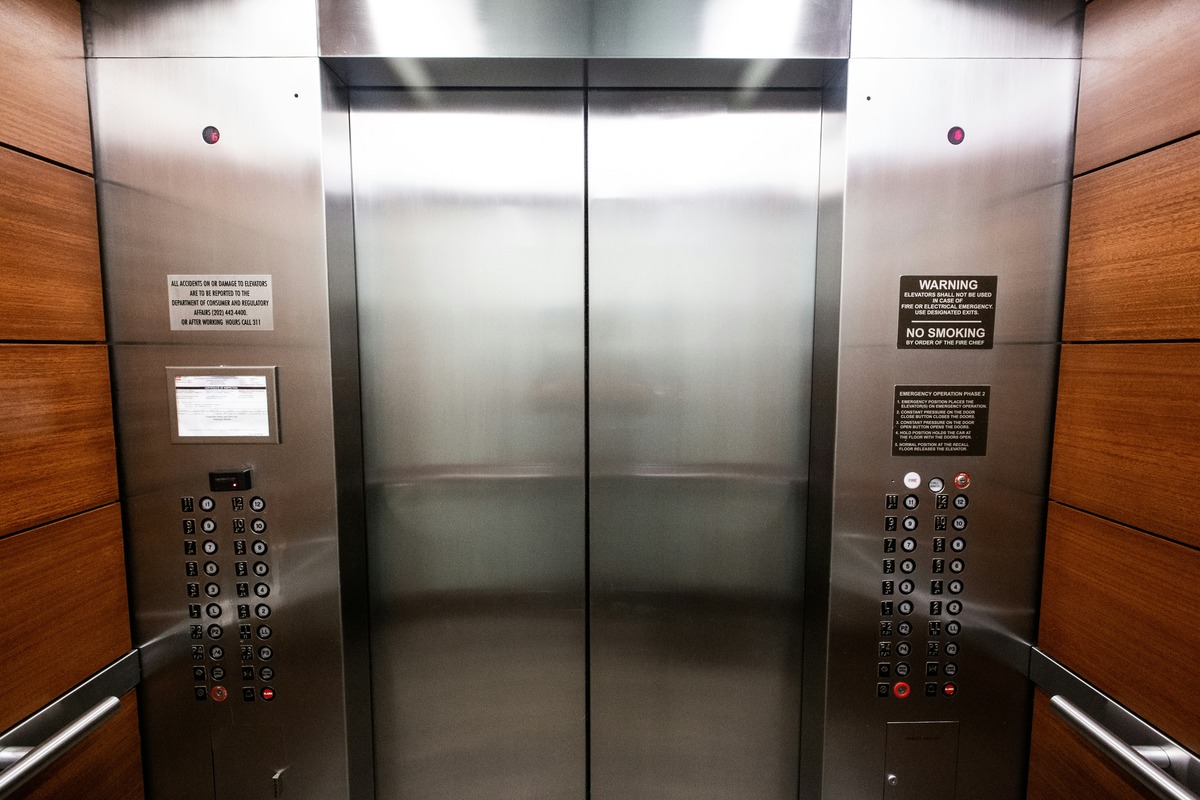Home>Science>The Mind-Blowing Science Behind Elevators And Lifts!


Science
The Mind-Blowing Science Behind Elevators And Lifts!
Published: January 27, 2024
Explore the fascinating science behind elevators and lifts and discover the incredible innovations shaping the future of vertical transportation. Delve into the world of science and engineering to understand the magic of these essential inventions.
(Many of the links in this article redirect to a specific reviewed product. Your purchase of these products through affiliate links helps to generate commission for Noodls.com, at no extra cost. Learn more)
Table of Contents
Introduction
Elevators, also known as lifts in some regions, are an integral part of modern urban life, revolutionizing the way we navigate and inhabit tall buildings. The science behind elevators is nothing short of remarkable, encompassing principles of physics, engineering, and technology. As we delve into the fascinating world of elevators and lifts, we will uncover the intricate mechanisms, safety features, and the future advancements that continue to shape this essential mode of vertical transportation.
The evolution of elevators has been intertwined with the advancement of architecture and urban development, enabling the construction of awe-inspiring skyscrapers that define the iconic skylines of major cities worldwide. Understanding the history and technological progression of elevators provides a profound insight into the human endeavor to conquer vertical space and enhance accessibility within urban landscapes.
In this exploration, we will unravel the mechanisms that enable elevators to defy gravity and transport passengers with precision and safety. From the counterweight systems to the sophisticated control algorithms, the inner workings of elevators are a testament to human ingenuity and scientific innovation. Moreover, we will uncover the diverse types of elevators, ranging from hydraulic and traction elevators to pneumatic and machine-room-less (MRL) designs, each tailored to specific architectural and functional requirements.
Furthermore, safety is paramount in the realm of elevators, and we will delve into the cutting-edge features and protocols that ensure the well-being of passengers and maintenance personnel. The incorporation of emergency brakes, redundant control systems, and stringent maintenance standards reflects the unwavering commitment to safety within the elevator industry.
Looking ahead, the future of elevators holds tremendous promise, with advancements in materials, energy efficiency, and smart technologies poised to redefine vertical transportation. The integration of artificial intelligence, regenerative drive systems, and destination dispatching heralds a new era of elevators that are not only efficient and sustainable but also seamlessly integrated into the fabric of smart cities.
As we embark on this exploration of the science behind elevators and lifts, we will unravel the intricacies, marvel at the innovations, and gain a profound appreciation for the indispensable role they play in shaping the modern urban landscape. Join us on this enlightening journey as we ascend to new heights of understanding and appreciation for the marvels of vertical transportation.
History of Elevators
The history of elevators is a captivating journey that intertwines with the evolution of architecture, urbanization, and technological innovation. The concept of vertical transportation dates back to ancient civilizations, where rudimentary forms of elevators were employed to hoist heavy loads and facilitate construction. However, it was during the Industrial Revolution that significant advancements in elevator technology began to emerge.
In the early 19th century, steam-powered hoists and crude elevator prototypes were utilized in factories and warehouses, revolutionizing industrial operations by streamlining the movement of goods and materials within multi-story structures. One of the pioneering figures in elevator history is Elisha Graves Otis, whose invention of the safety brake in 1852 laid the foundation for the safe and practical use of passenger elevators.
The introduction of passenger elevators in the mid-19th century marked a pivotal moment in urban development, as it enabled the construction of taller buildings and paved the way for the iconic skyscrapers that define modern cityscapes. The installation of the first passenger elevator in a commercial building, the Equitable Life Building in New York City in 1870, heralded a new era of vertical transportation, transforming the urban landscape and redefining architectural possibilities.
The late 19th and early 20th centuries witnessed remarkable advancements in elevator technology, including the transition from steam-powered systems to electric traction elevators, which offered enhanced speed, efficiency, and safety. The introduction of automatic controls, geared traction systems, and hydraulic mechanisms further propelled the evolution of elevators, making them indispensable in high-rise buildings and urban infrastructure.
The post-World War II era brought about a surge in skyscraper construction, driving the demand for more advanced and efficient elevator systems. This led to the development of high-speed elevators, destination dispatching, and machine-room-less (MRL) designs, catering to the evolving needs of modern architecture and urbanization.
Today, the history of elevators stands as a testament to human ingenuity and the relentless pursuit of vertical mobility. From humble beginnings as rudimentary hoists to the sophisticated, high-speed elevators that shuttle passengers through the world's tallest structures, the evolution of elevators mirrors the ascent of urban civilization and the boundless possibilities of vertical transportation.
The history of elevators is a testament to human ingenuity and the relentless pursuit of vertical mobility. From humble beginnings as rudimentary hoists to the sophisticated, high-speed elevators that shuttle passengers through the world's tallest structures, the evolution of elevators mirrors the ascent of urban civilization and the boundless possibilities of vertical transportation.
How Elevators Work
Elevators operate on the fundamental principles of physics and engineering, utilizing a combination of mechanical, electrical, and control systems to transport passengers and goods between different levels of a building. The core components and mechanisms that enable the functionality of elevators are a testament to precision engineering and scientific ingenuity.
Counterweight System
One of the key elements in the operation of elevators is the counterweight system, which serves to balance the load of the elevator car. This system comprises a counterweight that is connected to the elevator car via a series of cables and pulleys. By offsetting a significant portion of the elevator car's weight, the counterweight minimizes the power required to move the car, resulting in greater energy efficiency and smoother operation.
Traction Mechanism
In traction elevators, the movement of the elevator car is facilitated by a traction system, typically consisting of steel ropes or belts that are attached to the car and looped around a motorized pulley. As the motor turns the pulley, the ropes/belts move, propelling the elevator car in the desired direction. This mechanism relies on the principles of friction and tension to ensure controlled and precise movement.
Control Systems
The operation of elevators is meticulously controlled by sophisticated systems that regulate speed, acceleration, and deceleration to provide a safe and comfortable ride for passengers. Modern elevators are equipped with advanced control algorithms that optimize efficiency and minimize wait times by coordinating the movement of multiple elevator cars within a building.
Safety Features
Elevators are equipped with an array of safety features to protect passengers and mitigate potential hazards. Emergency brakes, overspeed governors, and door interlocks are among the critical safety mechanisms that ensure the reliability and security of elevator operations. These features are designed to engage automatically in the event of a malfunction or power outage, safeguarding passengers from harm.
Power and Energy Efficiency
The energy requirements of elevators are a significant consideration in their design and operation. Regenerative drive systems, LED lighting, and energy-efficient motors are employed to minimize power consumption and reduce environmental impact. Furthermore, the integration of smart technologies allows elevators to optimize their energy usage based on traffic patterns and demand, contributing to sustainable building practices.
Vertical Transportation Engineering
The field of vertical transportation engineering encompasses the design, optimization, and maintenance of elevator systems to ensure seamless and efficient vertical mobility within buildings. Engineers and technicians leverage their expertise in mechanical, electrical, and software engineering to innovate and enhance the performance of elevators, reflecting the convergence of science and practical application in the realm of vertical transportation.
In summary, the operation of elevators is a symphony of mechanical precision, technological innovation, and safety engineering. The seamless orchestration of counterweight systems, traction mechanisms, advanced controls, and energy-efficient technologies culminates in the remarkable functionality of elevators, underscoring their indispensable role in modern urban infrastructure.
Different Types of Elevators
Elevators come in a diverse range of designs and configurations, each tailored to specific architectural, spatial, and functional requirements. The evolution of elevator technology has spawned a variety of types, each offering unique benefits and applications within the realm of vertical transportation.
Hydraulic Elevators
Hydraulic elevators utilize a hydraulic piston mechanism to move the elevator car. These systems are well-suited for low- to mid-rise buildings and are known for their smooth and quiet operation. Hydraulic elevators are often chosen for their cost-effectiveness and ease of installation, making them a popular choice for buildings with fewer floors.
Traction Elevators
Traction elevators rely on an electric motor-driven system that utilizes steel ropes or belts to move the elevator car. This type of elevator is ideal for high-rise buildings, offering greater speed and efficiency compared to hydraulic systems. Traction elevators are widely used in modern skyscrapers, reflecting their ability to accommodate the vertical transportation needs of tall structures.
Machine-Room-Less (MRL) Elevators
MRL elevators are characterized by their compact and space-saving design, as they integrate the elevator machinery within the hoistway, eliminating the need for a separate machine room. This feature makes MRL elevators particularly suitable for buildings with limited space or architectural constraints. The streamlined MRL design aligns with contemporary construction trends, where efficient space utilization is a priority.
Pneumatic Vacuum Elevators
Pneumatic vacuum elevators operate on a unique pneumatic system that uses air pressure differentials to move the elevator car. These cylindrical, transparent elevators offer a futuristic and elegant aesthetic, making them a popular choice for modern and avant-garde architectural settings. Pneumatic vacuum elevators are celebrated for their visual appeal and innovative technology, adding a touch of sophistication to building interiors.
Green Elevators
Green elevators, also known as eco-friendly elevators, are designed with sustainability in mind, incorporating energy-efficient components and regenerative drive systems to minimize environmental impact. These elevators align with the principles of sustainable architecture and contribute to the overall energy efficiency of buildings, reflecting a growing emphasis on environmentally conscious vertical transportation solutions.
Custom and Specialized Elevators
Custom and specialized elevators cater to unique architectural and functional requirements, offering tailored solutions for specific building designs and usage scenarios. This category encompasses panoramic elevators, inclined elevators, and bespoke designs that are crafted to complement the aesthetic and spatial dynamics of their respective environments. Custom and specialized elevators exemplify the versatility and adaptability of elevator technology.
The array of elevator types underscores the versatility and adaptability of vertical transportation solutions, accommodating a wide spectrum of architectural, functional, and aesthetic considerations. As the urban landscape continues to evolve, the diversity of elevator types plays a pivotal role in shaping the accessibility and efficiency of vertical mobility within buildings of all scales and complexities.
Safety Features in Elevators
Ensuring the safety of passengers and maintenance personnel is paramount in the design, installation, and operation of elevators. A comprehensive array of safety features and protocols is integrated into elevator systems to mitigate potential risks and uphold the highest standards of security and reliability.
Emergency Brakes
One of the fundamental safety mechanisms in elevators is the emergency brake system, designed to halt the elevator car in the event of a critical failure or power outage. These brakes engage automatically if the elevator exceeds safe operating speeds or encounters irregularities in the movement, providing a crucial safeguard against free falls or uncontrolled acceleration.
Overspeed Governors
Overspeed governors are essential components that monitor the speed of the elevator car, ensuring that it does not exceed safe limits. In the event of an overspeed condition, the governor activates the emergency brakes, preventing the elevator from surpassing its designated speed threshold and averting potential hazards related to excessive velocity.
Door Interlocks
Door interlocks are integral to the safe operation of elevators, as they ensure that the doors remain securely closed during transit and align precisely with the floors at each landing. These interlocks prevent accidental openings or closures of the elevator doors, minimizing the risk of entrapment or collision with the elevator shaft walls.
Redundant Control Systems
Modern elevators are equipped with redundant control systems that provide backup functionality in the event of primary system failures. These redundant controls serve as fail-safes, allowing the elevator to maintain operational integrity and facilitate safe passenger evacuation or maintenance procedures, even in the presence of critical malfunctions.
Fire-Service Operation
Elevators are equipped with dedicated fire-service modes that enable firefighters and emergency responders to utilize the elevators for evacuation and access to different building levels during fire incidents. These specialized operational modes adhere to stringent safety protocols and facilitate the swift and secure movement of personnel and equipment in emergency scenarios.
Regular Maintenance and Inspections
Comprehensive maintenance and inspection protocols are essential for ensuring the ongoing safety and performance of elevators. Scheduled maintenance activities, compliance with regulatory standards, and rigorous safety inspections by qualified technicians are imperative for identifying and addressing potential issues before they compromise the integrity of the elevator systems.
Passenger Communication and Monitoring
Modern elevators are equipped with communication systems that enable passengers to seek assistance in the event of an emergency or distress situation. Additionally, closed-circuit television (CCTV) monitoring and remote diagnostic capabilities provide real-time oversight and surveillance, enhancing the overall safety and security of elevator operations.
The incorporation of these safety features and protocols underscores the unwavering commitment of the elevator industry to prioritize passenger safety and operational reliability. By integrating advanced technologies, stringent safety standards, and comprehensive maintenance practices, elevators continue to exemplify the pinnacle of secure and efficient vertical transportation within the built environment.
Future of Elevators and Lifts
The future of elevators and lifts is poised to unfold a new era of vertical transportation, characterized by cutting-edge technologies, sustainable practices, and enhanced user experiences. As urbanization continues to shape the landscape of modern cities, the demand for efficient, safe, and environmentally conscious vertical mobility solutions has fueled a wave of innovation within the elevator industry.
Smart Technologies and Connectivity
The integration of smart technologies, including artificial intelligence (AI), Internet of Things (IoT), and predictive analytics, is set to revolutionize the functionality and performance of elevators. AI-powered elevator systems will optimize traffic flow, predict usage patterns, and adapt in real-time to dynamic building demands, resulting in reduced wait times, improved energy efficiency, and seamless passenger experiences. Furthermore, IoT connectivity will enable remote monitoring, predictive maintenance, and enhanced safety protocols, ensuring the reliability and operational readiness of elevator systems.
Energy Efficiency and Sustainability
The future of elevators and lifts is synonymous with a heightened emphasis on energy efficiency and sustainability. Regenerative drive systems, energy-efficient components, and eco-friendly materials will be integral to the design and operation of elevators, aligning with the overarching goal of reducing environmental impact and promoting sustainable building practices. Furthermore, the integration of renewable energy sources, such as solar and kinetic energy harvesting, will contribute to the eco-conscious operation of elevators, fostering a greener and more sustainable urban infrastructure.
Vertical Mobility Integration in Smart Cities
As cities embrace the concept of smart urban environments, elevators and lifts will play a pivotal role in the seamless integration of vertical mobility within the fabric of smart cities. Advanced destination dispatching systems, interconnected vertical transportation networks, and multi-modal transit hubs will optimize the flow of people within urban centers, enhancing accessibility, connectivity, and urban mobility. The synergy between elevators, public transportation systems, and pedestrian pathways will redefine the urban experience, fostering efficient and interconnected urban ecosystems.
Enhanced User Experiences and Design Innovation
The future of elevators and lifts will prioritize user-centric design, comfort, and accessibility, elevating the overall passenger experience. Innovations in cabin aesthetics, intuitive user interfaces, and personalized destination control will cater to the diverse needs of passengers, ensuring a seamless and enjoyable journey within vertical spaces. Moreover, the integration of augmented reality displays, interactive information systems, and personalized service features will elevate the sophistication and convenience of elevator experiences, reflecting a harmonious blend of technology and human-centered design.
Adaptive and Inclusive Vertical Transportation
The future of elevators and lifts will embrace inclusivity and accessibility, catering to the diverse mobility requirements of all individuals. Innovations in universal design, assistive technologies, and barrier-free access will ensure that elevators and lifts are welcoming and accommodating to people of all ages and abilities. From intuitive wayfinding systems to adjustable cabin configurations, the future of vertical transportation will prioritize equitable access and seamless mobility for everyone, fostering inclusive and diverse urban environments.
In essence, the future of elevators and lifts embodies a convergence of technological innovation, sustainability, user-centric design, and inclusivity, shaping a landscape of vertical transportation that is efficient, intelligent, and harmoniously integrated within the fabric of smart cities. As the trajectory of urban development continues to ascend, elevators and lifts stand as beacons of progress, facilitating the seamless and sustainable movement of people within the evolving urban tapestry.
Conclusion
In conclusion, the science behind elevators and lifts unveils a captivating tapestry of innovation, engineering prowess, and forward-looking ingenuity. From their humble origins as industrial hoists to the sophisticated vertical transportation systems that define modern urban landscapes, elevators have transcended mere functionality to become iconic symbols of human achievement and architectural ambition.
The history of elevators reflects the intertwined evolution of technology and urbanization, marking pivotal milestones in the ascent of skyscrapers and the redefinition of vertical mobility. The advent of passenger elevators in the 19th century heralded a paradigm shift in urban development, enabling the construction of awe-inspiring structures that continue to shape the skylines of major cities across the globe.
The intricate workings of elevators, encompassing counterweight systems, traction mechanisms, advanced controls, and energy-efficient technologies, underscore the precision engineering and scientific principles that underpin their seamless operation. The convergence of mechanical, electrical, and software engineering in the realm of vertical transportation exemplifies the harmonious fusion of science and practical application, culminating in the reliable and efficient movement of people and goods within buildings of all scales.
Moreover, the diverse array of elevator types, ranging from hydraulic and traction elevators to pneumatic vacuum and machine-room-less designs, reflects the adaptability and versatility of vertical transportation solutions. Each type is tailored to specific architectural, spatial, and functional considerations, catering to the evolving needs of contemporary urban environments and diverse building designs.
Safety remains paramount in the realm of elevators, with a comprehensive suite of features and protocols ensuring the well-being of passengers and maintenance personnel. The integration of emergency brakes, overspeed governors, redundant control systems, and meticulous maintenance practices exemplifies the unwavering commitment of the elevator industry to uphold the highest standards of security and operational reliability.
Looking ahead, the future of elevators and lifts is poised to unfold a new chapter of technological marvels, sustainability, and inclusive design. Smart technologies, energy-efficient systems, and seamless integration within smart cities herald a future where elevators not only optimize vertical mobility but also contribute to the overall fabric of sustainable and interconnected urban environments.
In essence, the science behind elevators and lifts encapsulates a narrative of human ambition, scientific innovation, and the relentless pursuit of efficient and secure vertical transportation. As we ascend to new heights of urban development and technological progress, elevators stand as testaments to the enduring synergy between science, engineering, and the human quest to conquer the vertical realm.








